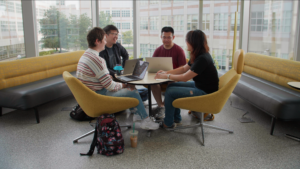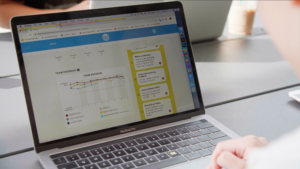Whether in high school or college, most of us have experienced the frustration of group work. There often is at least one student who doesn’t pull her weight, leaving the rest to pick up the slack. Then there is that person who takes over. He doesn’t allow anyone else to be heard.
More Info
Sometimes it happens in the workplace. There it can have serious consequences, however: lack of recognition or advancement or even termination for those who can’t participate effectively on teams.
 Hoping to help students before they reach advanced classes where they work in design teams, and before they leave the university to join corporate groups, three Michigan Engineering faculty members and the Center for Academic Innovation have developed and are testing a high-tech tool to help students build skills in research, communication and teamwork.
Hoping to help students before they reach advanced classes where they work in design teams, and before they leave the university to join corporate groups, three Michigan Engineering faculty members and the Center for Academic Innovation have developed and are testing a high-tech tool to help students build skills in research, communication and teamwork.
“By the time we find out about a problem on a team at the end of a class it’s too late. My heart goes out to students because two teammates have disappeared and their grades depend on it. It’s easy for one bad team experience to sour their entire thoughts on teamwork,” said Laura Alford, lecturer and research investigator in naval architecture and marine engineering.
Alford team teaches Intro to Engineering with Robin Fowler, lecturer in technical communication and research scientist in Engineering Education Research. The third colleague is Stephanie Sheffield, lecturer in technical communication and a former co-instructor of the Intro to Engineering course with Fowler and Alford.
“We see how hard it is to do teamwork and group work with diverse teams,” Alford said. “We see students struggle. But I can’t meet with all my students an hour every day, because there’s not enough time for that.”
Alford, Fowler and Sheffield know this all too well as they first tried a hands-on, time-consuming curricular model for weekly check-ins with students—something Fowler called “awesome and terrible” because the combination of peer assessment, reading and reflections gave the instructors a better sense of what was happening with the teams but the pace for instructors to read all of the material and provide feedback was not sustainable.
That’s when the trio reached out to Academic Innovation for help to combine their model with the technological approach of ECoach, a proven U-M-grown technology that tailors feedback and offers individualized course correction for students struggling in classes.
Their solution, called Tandem, was designed to help students navigate conflict, develop leadership skills and understand how different types of people work. It allows instructors to offer real-time correction when student group activities go off track.
“Our goal is that Tandem will determine when a team is not meshing in the ways that members need to and it will generate that support early on,” Sheffield said. “If it’s a minor issue, it will suggest readings or issues, and messaging to nudge them in the direction they need to go. Or nudge them to sit down with faculty or just raise the awareness that something’s going on here.
Students say the tool has helped eliminate some of the problems that come with group work. 
“My overall experience with group work has depended on the group, but it is always hard to figure out if members feel similarly about each other and the project as a whole,” said Michigan Engineering student Camber Hortop. “Tandem allows groups to quantify and track team dynamics. For those of us who like concrete data, it is a useful tool to translate into clear and visual terms how the group is feeling, in order to assess if further action is required.”
Scott Goutman, an aerospace engineering student, found the articles and resources provided with the tool to be most helpful.
One of his biggest takeaways from using the tool: “The idea that you envision when you begin a group project is going to be very different from the result. That is a normal part of the design and engineering process,” he said.
Engineering 100 student Emily Grim has experienced the pros and cons of group work inside and outside of classes and said working as a team in a course is much more difficult. She said Tandem allowed members to voice concerns without fear and it helped the members all get on the same page.
“I personally loved the Tandem feature where group members can rate each other’s contributions. My group had a member who severely lagged in pulling his own weight in projects, and we could tell him that in a way he couldn’t argue it or get upset with us,” Grim said. “This feature also helped me by showing me the things I did well and the things I could improve on, which were all things I didn’t initially see as areas for improvement.”
Molly Maher, a behavioral scientist from Academic Innovation and member of a team that developed Tandem, said Grim’s insight into her own performance in the group is key.
“The core message to get across is that there will be problems when you work on teams, and that you play a part in them and have options for how to respond. And knowing more about yourself and understanding team members is the way to do that,” Maher said. “The real theme is: what can you do about this? You can’t expect to change team members or change that the semester is hard, but we can encourage you to reflect on what you can act on yourself.”
The tool was alpha tested in winter 2019 and is being piloted with a section of Engineering 100, Business Administration 200 and Architecture 672 this fall. The testing will continue in Engineering 100 and in the School of Information 339 in winter 2020, and the business and architecture courses plan to use it again in the future.


